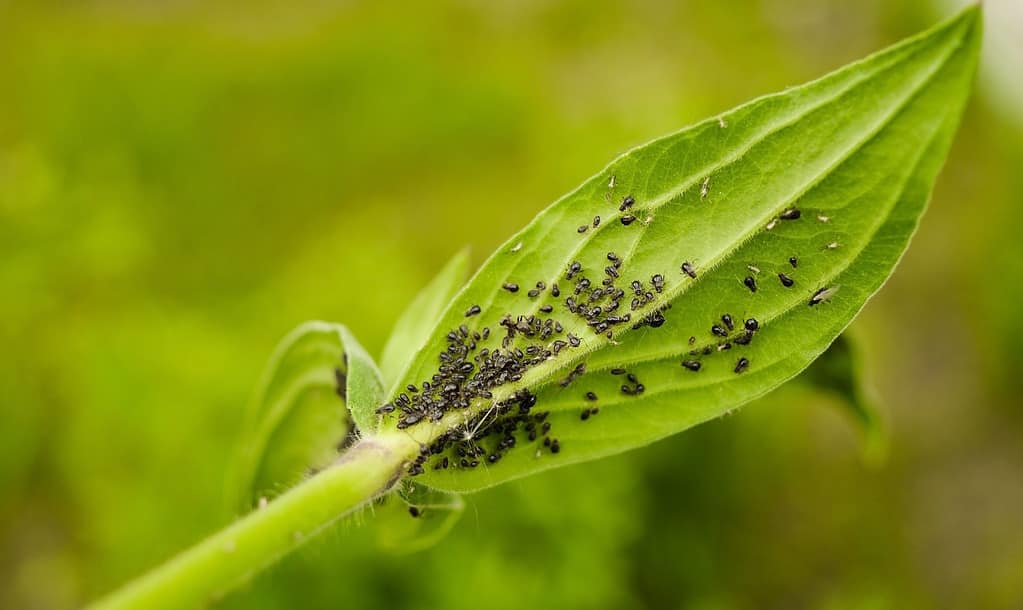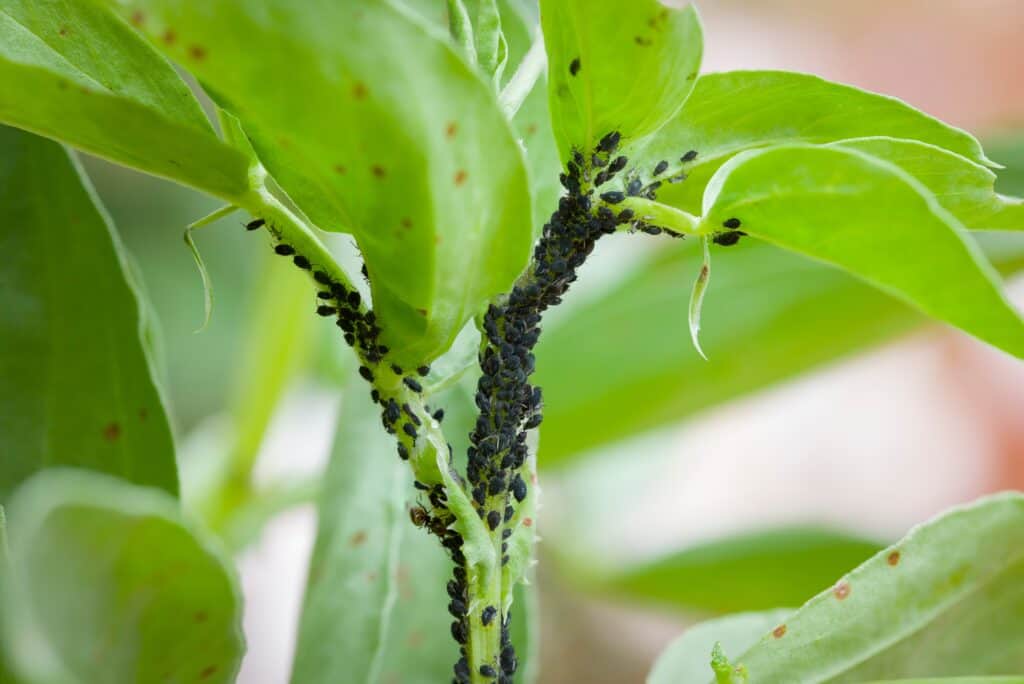Black Aphids
One of the most destructive pests in the world
Advertisement
Black Aphids Scientific Classification
Read our Complete Guide to Classification of Animals.
Black Aphids Conservation Status
Black Aphids Facts
- Name Of Young
- Larvae
- Group Behavior
- Social
- Fun Fact
- One of the most destructive pests in the world
- Biggest Threat
- Insecticides, predators
- Most Distinctive Feature
- Produce sugary excretions
- Other Name(s)
- Blackfly
- Habitat
- Temperate zones
- Predators
- Ladybugs, praying mantis, wasps, spiders
- Diet
- Herbivore
- Lifestyle
- Diurnal
- Favorite Food
- Sap
- Number Of Species
- 4999
- Location
- Worldwide
- Nesting Location
- Under leaves
- Migratory
- 1
View all of the Black Aphids images!
Black aphids are small, sap-sucking insects in the superfamily Aphidoidea. The term black aphid does not refer to a single species, but rather several species. These “black aphids” differ in size, shape, and behavior, but generally appear dark brown or black, hence the name. Black aphids are among the most destructive and difficult to remove of all garden pests. They can reproduce both sexually and asexually, which allows them to multiply extremely quickly.
5 Black Aphid Facts
- Excess sugar in a black aphid’s diet is expelled in the form of a sugary droplet known as honeydew.
- Black aphids begin life as flightless juveniles and develop working wings as they mature, enabling them to migrate to new host plants.
- Some black aphids attract ants that protect the aphids from predators in exchange for the sugary honeydew produced by the aphids.
- Black aphids often serve as vectors of diseases that can harm plants, and the honey they produce can lead to the growth of sooty mold.
- The eggs of black aphids can survive temperatures up to -25 degrees Fahrenheit.

Black aphids are among the worst crop and garden pests in the world.
©iStock.com/Irina Starikova
Species, Types, and Scientific Name
All black aphids belong to the aphid family Aphididae in the true bug order Hemiptera. The famed Swedish botanist, zoologist, and taxonomist Carl Linnaeus coined the New Latin term aphides. To date, the reasoning behind his decision remains unknown. According to one theory, the term “aphid” derives from the Greek word apheides, meaning “lavishly bestowed,” or “unsparing.” The theory is that Linnaeus chose this name in reference to the amazing reproductive capacity of aphids.
As previously mentioned, the term “black aphid” does not refer to one specific species, but rather numerous different aphid species. Most aphids belong to the subfamily Aphidinae, which contains 283 genera and over 3,200 described species. Other aphid subfamilies include Lachninae, or the “giant aphids,” Hormaphidinae, Calaphidinae, Chaitophorinae, and Eriosomatinae, or the “wooly aphids.”
While numerous species fall under the umbrella of “black aphids,” the species most commonly associated with the group is the black bean aphid (Aphis febae). The black bean aphid belongs to the genus Aphis in the subfamily Aphidinae. Its specific name, febae, derives from the Latin word faba, meaning “bean,” a common host plant for the species.
Other species commonly referred to as black aphids include:
- Melon Aphids – Aphis gossypii
- Giant Willow Aphids – Tuberolachnus salignus
- Cowpea Aphids – Aphis craccivora
- Hedgehog Grain Aphid – Sipha maydis
- Elder Aphids – Aphis sambuci
- Waterlily Aphids – Rhopalosiphum nymphaeae
Appearance: How to Identify Black Aphids
Black aphids share most of the same characteristics as other aphids. They possess soft, pear-shaped bodies with a pair of small tubes near the rear of the abdomen. These tubes, known as cornicles, exude the excess sugar known as honeydew created as a result of the black aphids’ sugar-rich diet.
Typically, black aphids in early spring and summer lack wings. These wingless forms go by the name ”apterous” morphs, while winged morphs are called “alates.” Like all aphids, black aphids have long mouthparts known as a rostrum that they use to suck sap. They also possess fairly long antennae and small eyes.
In terms of size, most black aphids range between 2 and 6 millimeters long, with most averaging less than 3 millimeters. As their name implies, all black aphids appear predominantly black or dark brown. That said, color differences vary, with some appearing dark red, gray, or tan.

Black aphids, such as the black bean aphid, possess soft, pear-shaped bodies with a pair of small tubes near the rear of the abdomen.
©Sascha Kohlmann / Flickr – License
Habitat: Where to Find Black Aphids
You can find black aphids on every continent except Antarctica. While they live worldwide, they typically prefer temperate climates. You’ll typically find black aphids on the undersides of leaves or the stems of host plants. That said, winged aphids can migrate incredible distances in order to seek out new food sources. They live both outdoors in gardens, fields, woodlands, and farms, as well as indoors in homes and in greenhouses.
For example, black bean aphids originated in Europe and Asia. However, they have since spread worldwide. You can now find black bean aphids in North America and parts of Africa and South America. This same story is true for many other black aphids. Due to the growth in global shipping and trade, aphids can easily transfer from one region to another by hitching a ride on plants and other produce.
Diet: What Do Black Aphids Eat?
In technical terms, black aphids are phloem feeders. Phloem refers to the vascular tissue in plants that moves sugars and other nutrients to and from the leaves, shoots, and roots of the plant. Black aphids obtain sap from plants by mechanically sucking the sap from phloem tubes using their soft-bodied mouthparts. Plant sap contains high levels of sugar but little protein or other nutrients. As a result, black aphids must consume enormous quantities of sap in order to get enough protein and other amino acids needed to survive. They tuck away the excess sugar in their rectum and excrete it later as honeydew.
Black aphids feed on different host plants depending on the species. While some species feed on only a handful of host plants, others may parasitize dozens or hundreds of different plants. For example, black bean aphids typically feed on shrubs like spindle trees or mock oranges during the spring and autumn. These plants serve as hosts for black bean aphid eggs. Meanwhile, they feed on various host plants during the summer, including sugar beets, celery, tobacco, spinach, and beans, hence their name. In total, black bean aphids feed on over 200 different plant species.
Let’s take a look at the dietary preferences of a few other black aphid species. For instance, melon aphids often feed on squash, cucumber, or watermelon. Meanwhile, cowpea aphids are often pests of beans and legumes, including cowpeas, chickpeas, and peanuts. Some aphids target more unusual host plants. For example, water lily aphids prefer to feed on water lilies and other aquatic plants, while willow aphids normally feed on the leaves of willow trees.

Black aphids feed on different host plants depending on the species.
©Paul Maguire/Shutterstock.com
Prevention: How to Get Rid of Black Aphids
Black aphids are among the worst crop and garden pests in the world. These little insects suck the life out of plants and can leave unsightly sooty mold on leaves and stems. Unfortunately, many commercial insecticides do not prove effective at getting rid of aphids. Aphids can develop resistance to certain insecticide solutions, and often cling to the bottom of leaves, which makes them hard to reach. As a result, many people turn to alternative solutions to remove black aphids from plants.
To remove black aphids, you can try creating a solution of water and dish soap and using them to coat plants. Alternatively, you can try creating a solution of white vinegar and water. Aphids find both solutions distasteful, which in turn can protect your plants.
Another effective method includes spraying infected plants with a high-pressure water hose. Just remember, the water pressure must be strong enough to knock the aphids off the plant, but not too strong to damage the plant itself. Some gardeners swear by other methods, such as the use of diatomaceous earth or certain essential oils. You can always try several solutions to see which method works best for you.
Related Animals
View all 285 animals that start with BBlack Aphids FAQs (Frequently Asked Questions)
What do black aphids eat?
Like all aphids, black aphids are herbivores that eat the sap of plants. They typically prey on a handful of host plants and use a pump mechanism in their heads to suck phloem sap from leaves and stems.
Why do ants take care of black aphids?
Ants sometimes develop a mutualistic relationship with black aphids, wherein the ants protect the black aphids from predators in exchange for the honeydew produced by the aphids. So-called dairying ants act as farmers, as they tend for their herd of black aphids because of the sugary substance they create as a byproduct of their diet.
What is sooty mold?
Sooty molds are a type of sac fungi. They typically grow on plants or fruit as a result of excess sugar. This sugar sometimes oozes out of the plant on its own, or is left on the plant by aphids in the form of honeydew.
Are all aphids female?
Black aphids can reproduce asexually in a process known as parthenogenesis. Female aphids give birth to live offspring, and these parthenogenetic aphids are almost always female. That said, male aphids also exist, as they are required to sexually fertilize the females’ eggs that overwinter until spring.
Thank you for reading! Have some feedback for us? Contact the AZ Animals editorial team.
Sources
- University of Idaho, Available here: https://www.uidaho.edu/extension/ipm/pests/aphid-adelgid/black-bean-aphid
- Wisconsin Horticulture, Available here: https://hort.extension.wisc.edu/articles/aphids/
- ScienceDirect, Available here: https://www.sciencedirect.com/topics/agricultural-and-biological-sciences/black-bean-aphid

















